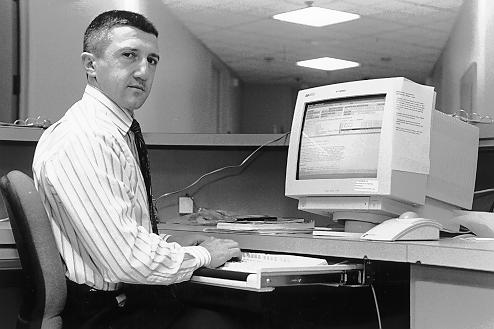
Since it went on-line in January, the Medical Archiving System has greatly expanded VUMC's computerized information management capabilities, says Dario Giuse, Ph.D., associate professor of Biomedical Informatics.
MARS system on-line as patient information model
Many medical institutions spend two to four years and upwards of $6 million to computerize patient information and make it accessible to several people at once.
Vanderbilt University Medical Center has done it in less than one year – for less than $500,000 – and is fast becoming an information management model for other academic health centers across the country.
The Medical Archiving System (MARS), which has been running since January, now has over 2,000 users and makes patient information easy to access and understand. VUMC's long-term initiative is to build a reusable and flexible information management infrastructure that involves the input of both the medical staff and computer scientists.
VUMC is only the second school to use the system, which was developed at the University of Pittsburgh. Representatives from other of the nation's top academic medical centers, such as Harvard and Duke universities, attended a conference at VUMC recently to learn about the MARS system and the Integrated Advanced Information Management System (IAIMS).
The September 27 seminar focused on how medical centers can better develop communication strategies between departments.
MARS runs on what is called a distributed parallel system, which means that several machines work simultaneously on the same request. It also means that if the system starts to run a little slowly, adding a new machine to the existing ones speeds it back up. This process can be done while the system is running so there is no need to shut it down for repairs, said Dario A. Giuse, associate professor of Biomedical Informatics.
"For example, the University of Pittsburgh is now running a large system of 150 machines and they have never had a problem with performance."
When the system first went on-line, it contained radiology reports, anatomic pathology reports, discharge summaries and laboratory results. This has now been expanded to include a host of other information.
"In the past several months we have added many new types of data such as results from specific studies from echocardiography, catheterization studies, Doppler studies from the Vascular Lab, operative notes, clinic notes and letters. We are compiling a more complete electronic patient record so that physicians can go to MARS and find all the information they need," said Giuse.
One of the services being contemplated for the future is an interface to the World-Wide Web so that VUMC's primary care affiliates and staff physicians can check on patients from their home or office. As of now, the only way to access the MARS system is through one of the shared workstation terminals (the ones with the big floating V on the screen).
The Internet feature would allow doctors to stay abreast of their patients' conditions no matter where they are. By knowing the exact conditions of their patients instantly, they can give better care.
"The pilot for this program is going on in the seventh floor of Medical Center East and they are very satisfied with it," said Giuse.
Internet access would protect patient confidentiality by transmitting documents from a secure server so that the data will be transmitted in a protected, encrypted form. Security measures already in place include the use of a username and a password that must be entered to log on to the system.
The MARS system may also assume the reporting function of the current laboratory computer. The system currently in place is fairly old and needs to be replaced, Giuse said.
"By moving the reporting functions out of the lab system and into MARS we can guarantee that as soon as the laboratory people are ready to replace their system, they will not have to worry about buying a system that reports test results, and can instead concentrate on buying the best system for handling their clinical workload," he said.
"We are also exploring the process of physician note transcription. We would like to make all transcribed notes part of the patient's electronic file," said Giuse.
The notes would be given on tape to a transcription service that would then send the note to the physician via the MARS system. The physician would have a chance to look at the note and make any changes before it was officially posted as part of the patient's file.
The advantage in this system is that the physician could make changes from anywhere in the hospital at any time. If they had five minutes in between patients, they could do it at any of the terminals instead of going back to their office to make the changes, Giuse said.













